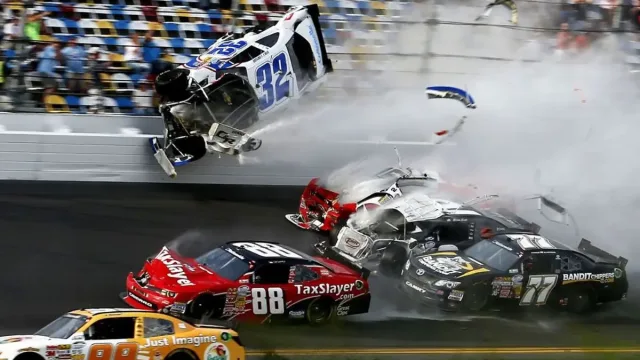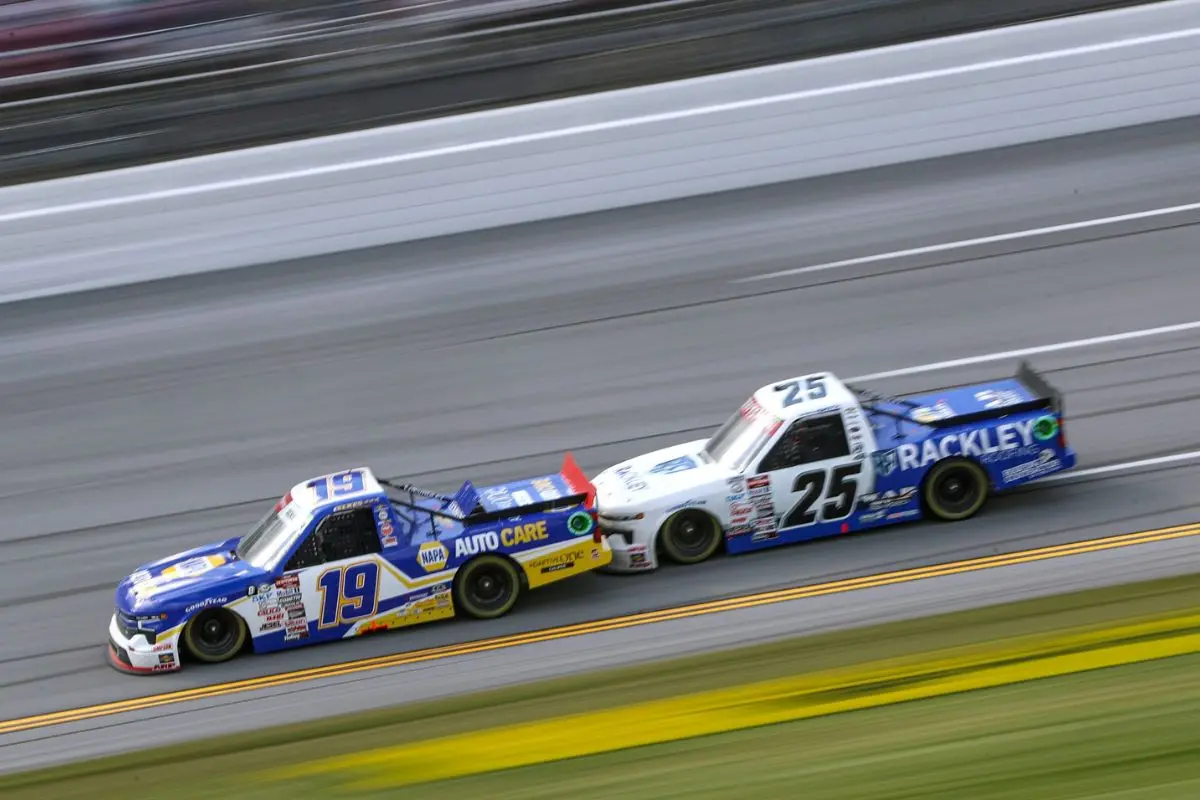Back in 2000, NASCAR fans witnessed a terrifying moment when a NASCAR driver barely escapes fiery Daytona crash during the inaugural Daytona 250. A devastating wreck on lap 57 transformed the race into chaos, with flames, flying debris, and injured spectators shocking everyone at the track. What led to this disaster over two decades ago? How did the safety systems of the time handle such an intense situation?
Key Highlights
- The crash during the Daytona 250 involved drivers Lyndon Amick, Kurt Busch, Rob Morgan, and Geoffrey Bodine, leading to significant chaos on the track.
- Geoffrey Bodine suffered serious injuries, including a concussion and mid-back fracture, but the roll cage around his seat remained intact.
- The incident generated a fireball and debris, injuring several spectators, with five hospitalized and two requiring surgery.
- Daytona International Speedway crews quickly repaired 150 feet of damaged catch fencing, highlighting the effectiveness of existing safety measures.
The Incident: A Devastating Crash at Daytona
What could have led to such a catastrophic event during the inaugural Daytona 250? The crash, which unfolded on lap 57 of the 100-lap race, was precipitated by a series of unfortunate maneuvers among multiple drivers. As Lyndon Amick, Kurt Busch, and Rob Morgan raced three abreast at the start-finish line, the delicate balance of speed and positioning shifted dramatically. Busch’s contact with Morgan initiated a chain reaction that ultimately culminated in a considerable loss of vehicle control, propelling the incident forward.
When Morgan collided with Geoffrey Bodine’s truck, the impact was severe. Bodine’s vehicle was propelled into the air, climbing the concrete wall before crashing into the catch fence. This dramatic ascent not only indicated the force of the collision but also emphasized the vulnerabilities inherent in high-speed motorsport.
As Bodine’s truck tumbled, it became a projectile, resulting in a series of barrel rolls that were both mesmerizing and frightening. The subsequent collision with another truck exacerbated the situation, igniting a fireball and scattering debris across the venue.
The aftermath of this incident was dire, with nine spectators and Bodine suffering injuries as a result of flying debris. The Daytona 250 crash serves as a harsh reminder of the fine line between exhilarating competition and perilous risk, prompting critical discussions on safety measures and event management within the NASCAR community.
Injuries and Medical Updates
How did the aftermath of the Daytona 250 crash unfold for those involved? The incident left multiple injuries in its wake, with NASCAR driver Geoffrey Bodine sustaining serious injuries that have since been publicly detailed. Bodine remains in serious but stable condition at Halifax Medical Center, grappling with a concussion, mid-back fracture, and severe lacerations among other injuries. Despite his own distress, Bodine particularly expressed concern for the injured spectators, highlighting the emotional toll of such incidents beyond the immediate physical trauma.
Driver Jimmy Kitchens was also transported for neck soreness and stiffness, emphasizing the varied impact of the crash on those involved. The spectators, however, bore the brunt of the flying debris, with five individuals hospitalized. Among them, two required surgical intervention, one for a fractured arm and another for considerable facial injuries.
Eyewitness Accounts and Emotional Impact
Witnessing the chaos of the Daytona 250 crash left an indelible mark on both fans and drivers, amplifying the emotional toll of the event. The visceral reactions captured in the accounts of those present reveal a shared sense of terror and disbelief that surpasses the boundaries of the racetrack.
Todd Bodine, a seasoned driver and brother of Geoffrey, articulated the harrowing nature of the incident, describing it as “one of the most violent” he had ever witnessed. This perspective highlights the psychological strain not only on the spectators but also on those who participate in the sport.
“I’ve seen some bad wrecks, and I’ve been in a couple of bad wrecks. That’s probably one of the most violent wrecks you’ll ever see.” – Todd Bodine
Fans like Marcia Wagner, positioned eight rows up, recounted the overwhelming intensity of the flames and heat, characterizing the experience as “very, very frightening.” Such direct accounts expose the raw emotions that accompany racing, emphasizing the unstable balance between exhilaration and danger.
The experience of Troy Fiscus, who instinctively shielded his girlfriend from flying debris, further demonstrates the instinctual reactions that arise in moments of crisis.
Moreover, the injuries sustained by spectators, including Dan Mackie and Gayle Hertlein, add a layer of somber gravity to the incident, with debris damaging personal belongings and, more alarmingly, causing physical harm.
Safety Measures and Response Efforts
The harrowing experience of the Daytona 250 crash has reignited discussions around the importance of safety measures in motorsport. The incident serves as a notable reminder of the inherent risks involved, yet it also highlights the efficacy of existing safety protocols. NASCAR’s commitment to improving driver and spectator safety is evident through specific measures that proved vital during this event.
- Intact Roll Cage: The roll cage surrounding driver Bodine’s seat remained intact despite the truck’s disintegration, showcasing the effectiveness of engineering in preserving driver safety during catastrophic incidents.
- Catch Fencing Repairs: Following the crash, crews undertook a considerable repair effort, restoring 150 feet of damaged catch fencing in a 2-hour, 23-minute red flag period. This rapid response highlights the importance of track infrastructure in containing debris and protecting spectators.
- Replacement of Fence Posts: Seven of the eight affected fence posts were replaced, ensuring that the track’s integrity was restored before the race could resume. This swift action showcases the careful attention to detail in safety protocols.
- Containment Effectiveness: John Graham, president of Daytona International Speedway, confirmed that the fencing successfully contained the crash, preventing potential injury to a larger number of spectators. This incident emphasizes the vital role of extensive safety systems in mitigating disaster.
Race Outcome and Aftermath
In the midst of the chaos of the Daytona 250, the race ultimately wrapped up with a remarkable display of resilience and determination. Mike Wallace emerged victorious, triumphing before an estimated crowd of 90,000, a demonstration of the enduring spirit of the sport even in the face of adversity.
The aftermath of the incident reinforced the inherent risks associated with motorsport, highlighting the fine line between exhilarating competition and potential disaster.
The ending of the race, following the necessary repairs and safety protocols, showcased not only the robustness of NASCAR’s safety measures but also the steadfast dedication of teams and officials. Despite the harrowing crash that sent debris flying into the stands, leading to injuries among spectators, there were no fatalities—a fact that speaks volumes about the efficacy of rapid medical response and track management.
Interestingly, in the wake of the incident, NASCAR did not announce any immediate changes to race regulations, suggesting a confidence in existing safety protocols. This decision could be seen as indicative of the organization’s commitment to maintaining the integrity of the sport while prioritizing the well-being of its participants and fans.
News in Brief: NASCAR Driver Barely Escapes Fiery Daytona Crash
The Daytona crash emphasizes the inherent risks associated with motorsport, highlighting the need for continuous advancements in safety protocols. The incident not only resulted in considerable injuries to spectators but also prompted a reevaluation of existing protective measures. Eyewitness accounts reveal the emotional toll such events impose on both participants and fans.
ALSO READ: NASCAR Driver’s Career Ruined by His Father’s $25 Million Fraud and Lavish Spending




